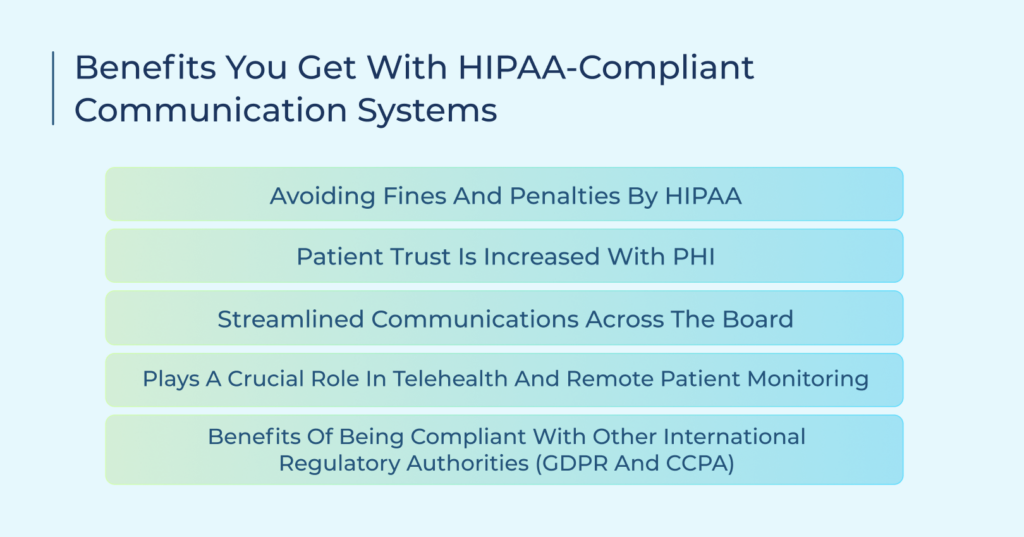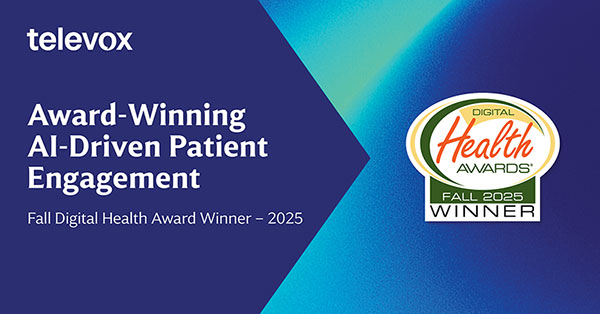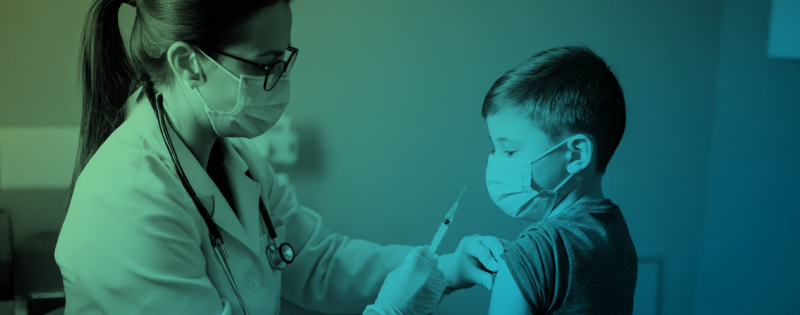Televox is proud to announce that its Enterprise Edition SMS solution has been awarded Gold…

HIPAA-Compliant Messaging in Healthcare: How to Achieve It
The Health Insurance Portability and Accountability Act (HIPAA) governs every patient interaction for healthcare providers. It establishes strict rules for handling Protected Health Information (PHI) in all forms of communication.
Healthcare providers are, hence, expected by federal law to adhere to these regulations by securing their messaging services and data storage systems in order to ensure only authorized individuals can access patient information. This blog post helps you avoid penalties that come with HIPAA infractions while keeping your patient communications clear and effective.
Understanding HIPAA Compliance for Communication in Healthcare
Similar to how every industry has a regulatory body that enforces compliance standards to safeguard customer data and records, HIPAA sets the ground rules for protecting patient information. These strict regulations require healthcare providers to use secure channels and procedures for their daily communications.
This is because medical data contains personal and often sensitive details about patients that should never be exposed to the public. From treatment plans and test results to prescriptions and billing information, HIPAA demands care providers to maintain absolute privacy of their patients or else face serious consequences.
Key Requirements for a Messaging System to Be HIPAA-Compliant
Every healthcare facility or organization has to follow specific standards to safeguard their patients’ health information. Below are some critical requirements in that regard for any provider to meet HIPAA compliance.
Encrypted Data for Security
The best way to protect patient information is through end-to-end encryption. It converts messages or any transmitted data into unreadable information that only authorized recipients can read. Otherwise, unencrypted data carries a significant risk of being captured or breached during transit.
Secured Data Storage and Retention
HIPAA also requires healthcare providers to safely store PHI in their servers and data centers. This demands another set of encryption protocols as well as regular backups to ensure no data is lost.
It is a best practice to only give authorized and experienced personnel access rights to data storage. Pair that with strict deletion procedures, and the risk of accidentally deleting data becomes zero while ensuring permanent deletion of any PHI when necessary or when the data is no longer needed.
Use Authentication and Access Mechanisms
In addition to role-based access controls, use multi-factor authentication to add another layer of security. Regularly change passwords and encrypt the files containing the passwords. Something else that HIPAA appreciates is automatically terminating inactive sessions. This ensures that any staff members who are away from their desks or devices do not leave sensitive patient data exposed to unauthorized access.
Keeping and Maintaining Activity Logs
Another critical requirement of HIPAA-compliant messaging is a comprehensive activity log. There needs to be an audit trail that tracks every access to PHI, including who viewed what information and when.
Strict real-time monitoring is how healthcare providers are able to detect unusual patterns and take quick actions in the case of security breaches. Just like with PHI, your activity logs must be protected from tampering and unauthorized access as well.
Business Associate Agreement (BAA) Compliance
HIPAA expects healthcare providers to have formal relationships with their service vendors. BAAs are legally binding contracts that make vendors responsible for protecting PHI on their end. Without a proper BAA agreement, providers risk significant compliance violations.
Prevention of Unauthorized Access on Stolen or Lost Devices
Branching from the same data-encryption aspect is a policy for when devices are lost or compromised. Encrypted devices ensure their data remains protected when lost, while remote wipe capabilities allow you to permanently delete sensitive information instantly. Think of it as a two-front safeguard. There need to be clear and robust security policies in place that define acceptable use and access of all devices.
What Happens if Your Communication Is Not HIPAA-Compliant in Healthcare?
Non-compliant communication in healthcare creates serious consequences for organizations and staff. Here’s what can happen if you fail to meet HIPAA standards:
- Financial Penalties: HIPAA slaps fines on healthcare organizations for every violation. These can accumulate to become hefty sums. They start from $100 for minor violations but can accumulate to over $50,000. Additionally, individuals who breach or misuse PHI willingly are charged as criminals, with fines reaching $250,000.
- Legal Consequences: It doesn’t stop at fines. Repeated or major offenders can be charged with prison sentences based on intent: up to 1 year for negligence, 5 years for obtaining PHI under false pretenses, and 10 years for violations with malicious intent.
- Professional Repercussions: Healthcare organizations that fail to uphold HIPAA communication standards risk sanctions. They lose all credibility, which means a loss of patients. Additionally, professionals affiliated with the organization can see their ability to practice severely limited.
- Patient Impact: Trust is everything in the healthcare sector. You will never place your health concerns in the hands of a facility that is known to compromise patient information. This also opens doors to potential lawsuits following serious breaches of PHI.
Benefits You Get With HIPAA-Compliant Communication Systems
Healthcare providers need secure communication systems to protect patient information. HIPAA-compliant platforms like Televox stand out as a comprehensive enterprise communication platform that meets every requirement while providing a wealth of benefits for improved patient engagement and experiences.

Avoiding Fines and Penalties by HIPAA
This should be obvious. The biggest benefit of a HIPAA-compliant conversation is avoiding hefty financial penalties. It’s not just about not paying fines. Even minor violations can stack up to see major healthcare providers lose their credibility and trust within the community. Also, the legal documentation serves as evidence during lawsuits or audits.
Patient Trust Is Increased With PHI
Improving patient retention starts with HIPAA compliance. Patients need to feel comfortable sharing their personal information. There must be clear and transparent notices to inform patients how their medical data is being protected and how it is being used. Secure messaging creates a safe channel for confidential health discussions, leading to better trust.
Streamlined Communications Across the Board
HIPAA-compliant messaging platforms like TeleVox keep all patient communications centralized in a secure location. This allows your employees and care providers to communicate with patients confidently and with ease.
The goal of streamlining communications also paves the way for other features like secure file sharing and automated reminders to let healthcare providers focus on delivering better patient care without worrying about HIPAA violations.
Plays a Crucial Role in Telehealth and Remote Patient Monitoring
Many patients now expect healthcare organizations to provide remote consultations. Conducting online sessions without security measures carries the risk of data breaches. HIPAA supports telehealth features, so care providers automatically have to adhere to encrypting their systems to protect patient data for remote workers.
Benefits of Being Compliant With Other International Regulatory Authorities (GDPR and CCPA)
GDPR has much stricter consent requirements than HIPAA. CCPA, on the other hand, is not limited to just healthcare. It covers businesses based on size and data processing volume, so care providers cover a lot more areas of secure messaging.
Complying with such international standards demonstrates a commitment to protecting PHI and improving internal communications across the board.
How to Achieve HIPAA Compliance as a Healthcare Provider?
The following four-step process outlines how your healthcare organization can achieve HIPAA compliance. Keep in mind that each step is a general bird’s-eye view. There are multiple substeps involved, making each phase a comprehensive process in itself.
Step 1: Formulate Policies and Procedures for HIPAA-Compliant Communications
Start by creating specific protocols for managing PHI across all supported communication channels. Define security policies for digital messages along with detailed procedures to handle breaches if incidents occur.
On that note, identify potential vulnerabilities by creating risk assessment schedules. Have a proper backup process to safeguard your data. Also, assign compliance oversight roles to specific team members who will monitor adherence.
These documented policies form the foundation of your compliance program and provide guidance for staff in daily operations.
Step 2: Choose a HIPAA Compliant Communication Platform
Selecting the right technology partner determines your compliance success. Platforms like Televox offer essential security features, including end-to-end encryption that protects messages during transmission.
Look for systems with role-based access controls that limit PHI visibility based on job functions. The platform should record comprehensive audit logs and include automatic timeout features for inactive sessions.
Verify that your vendor provides a signed BAA to formalize their compliance obligations. However, do not just take their word for it. Test the patient portal security and emergency access protocols before implementation to confirm they meet HIPAA standards.
Step 3: Integrate the Compliant Patient Engagement Platform Into Your Current System
Connecting your new communication platform with existing systems requires careful planning. Map all data flows between your electronic health records and the new platform to identify potential security gaps. Establish secure connection methods between software systems and test all integration points to confirm PHI protection during transfers.
Update your technical documentation to reflect these connections and configure permissions consistently across platforms.
Step 4: Start Training to Stay Compliant
Staff education forms the critical link between policy and practice. Begin with comprehensive training for everyone who handles patient information, focusing on the practical application of HIPAA principles.
Schedule regular refresher sessions throughout the year to maintain awareness. Develop role-specific guidance that addresses the unique communication needs of different clinical and administrative positions.
Test knowledge through realistic scenarios that mirror daily challenges. Practice incident response through simulation exercises to prepare staff for potential breaches.
Designate privacy officers who can address compliance questions as they arise and document every training session, including attendance and topics covered.
Are Popular Instant Messaging Apps HIPAA Compliant?
You should always confirm if your apps align with HIPAA regulations. Even the most popular ones do not find themselves on the approval list, at least not in their original (default) forms.
- WhatsApp is not a HIPAA-compliant messaging system. While it features end-to-end encryption and is generally secure for everyday messaging, it is not considered the best option for medical staffers to communicate about their patients.
- SMS or texting messaging is not HIPAA-compliant because it lacks the necessary security safeguards. Messages are also stored on your carrier’s servers indefinitely, which is a major risk. That said, HIPAA does allow texting for patient-initiated communication, but within certain limitations.
- Emails containing PHI are also not HIPAA-compliant, but they can be by taking certain precautions. Gmail, for example, can be made HIPAA-compliant by using a Google Workspace account and having Google sign a BAA with your healthcare organization.
Some Examples of HIPAA-Compliant Message Communications
The messages below are just some notable examples that should be encrypted or be protected with other security measures to prevent unauthorized access in compliance with HIPAA standards.
Appointment Reminders: “Hello, John. This is [care provider name] reminding you about your appointment with [doctor name] on May 3 at 2:30 PM. Please reply YES to confirm or call 123-456-7890 to reschedule.”
Medication Alerts: “Hello, John. Your prescription refill for [medication name] is ready. Please bring your ID for pickup.”
Test Results Sharing: “Hello, John. Your test results are ready. You can view them here: [link]. Let us know if you’d like to discuss them.”
Post-Surgery Follow-Ups: “Hello, John. How are you feeling after your surgery? Please let us know if you have any concerns.”
Leverage the Power of Televox for Automated, HIPAA-Compliant Communication for Patients
TeleVox offers next-generation solutions for the healthcare industry. Our AI-driven SMART Agent handles your patient communications through phone, text, and chat while maintaining strict HIPAA compliance.
Your medical staff gets to focus purely on delivering the best care possible, while our SMART virtual agents answer patient questions, schedule appointments, and perform other routine tasks without any staff intervention.
Every interaction is encrypted and protected, ensuring patient data remains secure and only seen by authorized eyes.

Schedule a demo today and discover how you can start giving your patients the information they need quickly, securely, and on their terms.



